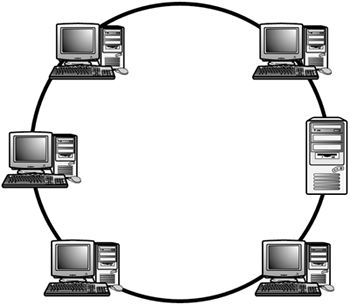
In a true ring topology, if a single computer or section of cable fails, there is an interruption in the signal. The entire network becomes inaccessible. Network disruption can also occur when computers are added or removed from the network, making it an impractical network design in environments where there is constant change to the network.
Ring networks are most commonly wired in a star configuration. In a Token Ring network, a multistation access unit (MSAU) is equivalent to a hub or switch on an Ethernet network. The MSAU performs the token circulation internally. To create the complete ring, the ring in (RI) port on each MSAU is connected to the ring out (RO) port on another MSAU. The last MSAU in the ring is then connected to the first, to complete the ring. Table 3 summarizes the advantages and disadvantages of the ring topology.
|
Advantages |
Disadvantages |
|---|---|
|
Cable faults are easily located, making troubleshooting easier. |
Expansion to the network can cause network disruption. |
|
Ring networks are moderately easy to install. |
A single break in the cable can disrupt the entire network. |